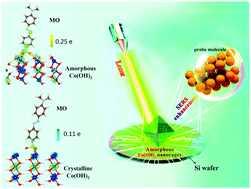Amorphous Co(OH)2 nanocages achieving efficient photo-induced charge transfer for significant SERS activity†
Abstract
Boosting substrate–molecule interactions, especially the strong vibronic coupling and efficient photo-induced charge transfer (PICT) transitions, is a critical issue to improve the surface-enhanced Raman scattering (SERS) sensitivity of non-metal substrates. Here, by developing amorphous Co(OH)2 nanocages (a-Co(OH)2 NCs), we succeed in obtaining an ultrahigh enhancement factor (1.56 × 105) and an ultralow limit of detection (10−10 M) for target molecules. X-Ray photoelectron spectroscopy and electron paramagnetic resonance spectroscopy demonstrate that these a-Co(OH)2 NCs possess more surface oxygen defects than the crystalline Co(OH)2, which results in numerous surface metastable electronic states. First-principles density functional theory simulations further reveal that the low coordination number of surface Co atoms and the richness of surface oxygen defects facilitate the formation of O–Co bonds and strong hydrogen bonding between a-Co(OH)2 and methyl orange (MO) molecules, which endow more facile and efficient interfacial charge transfer from the substrate to MO, and thus boost the formation of stable surface charge transfer complexes. Notably, the smaller bandgap of a-Co(OH)2 effectively improves the substrate–molecule vibronic coupling, which greatly promotes PICT transitions and enhances the Raman signal intensity. This clear observation of the remarkable SERS activity of amorphous hydroxide nanomaterials may open up new frontiers for highly sensitive and stable SERS technology.



 Please wait while we load your content...
Please wait while we load your content...